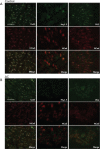Anisotropic Cardiac Conduction
- PMID: 33437488
- PMCID: PMC7788398
- DOI: 10.15420/aer.2020.04
Anisotropic Cardiac Conduction
Abstract
Anisotropy is the property of directional dependence. In cardiac tissue, conduction velocity is anisotropic and its orientation is determined by myocyte direction. Cell shape and size, excitability, myocardial fibrosis, gap junction distribution and function are all considered to contribute to anisotropic conduction. In disease states, anisotropic conduction may be enhanced, and is implicated, in the genesis of pathological arrhythmias. The principal mechanism responsible for enhanced anisotropy in disease remains uncertain. Possible contributors include changes in cellular excitability, changes in gap junction distribution or function and cellular uncoupling through interstitial fibrosis. It has recently been demonstrated that myocyte orientation may be identified using diffusion tensor magnetic resonance imaging in explanted hearts, and multisite pacing protocols have been proposed to estimate myocyte orientation and anisotropic conduction in vivo. These tools have the potential to contribute to the understanding of the role of myocyte disarray and anisotropic conduction in arrhythmic states.
Keywords: Anisotropy; anisotropic conduction; arrhythmias; conduction velocity; pacing.
Copyright © 2020, Radcliffe Cardiology.
Conflict of interest statement
Disclosure: The research was supported by the National Institute for Health Research (NIHR) Clinical Research Facility at Guy’s and St Thomas’ NHS Foundation Trust and NIHR Biomedical Research Centre based at Guy’s and St Thomas’ NHS Foundation Trust and King’s College London. The views expressed are those of the authors, and not necessarily those of the NHS, the NIHR or the Department of Health. JW is supported by a Medical Research Council UK Clinical Research Training Fellowship (grant code: MR/N001877/1). The authors have no other conflicts of interest to disclose.
Figures






References
Publication types
Grants and funding
LinkOut - more resources
Full Text Sources
Miscellaneous

